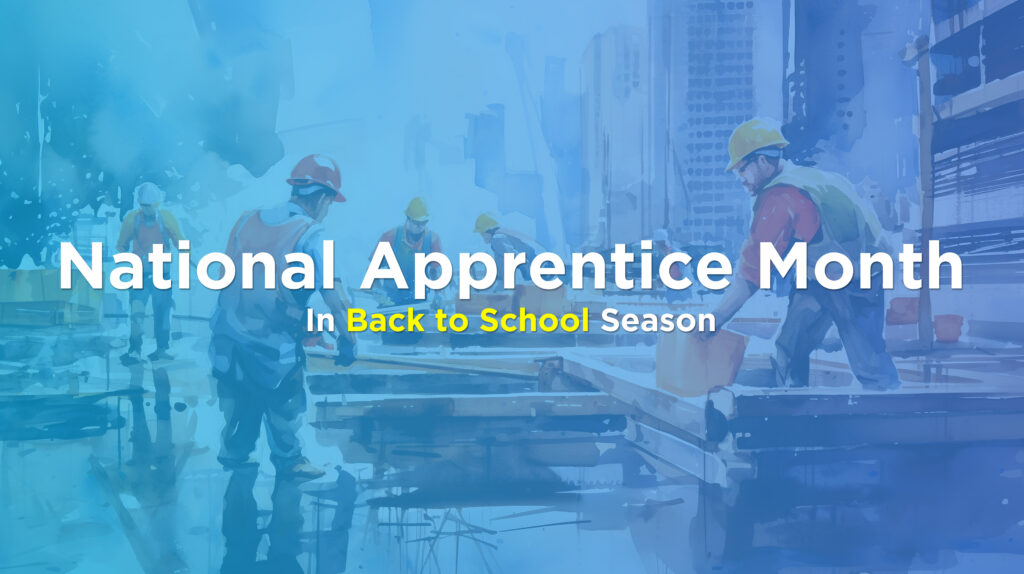Around the country, families are getting ready for the new school year. But August is more than just the month the school year starts. Since 1962, when it was declared National Apprentice Month by none other than John F Kennedy, it’s been a celebration of trades and apprentices.
Since schools are also vital in helping kids choose careers—including the trades—we thought this was the perfect time to take a closer look at careers in the trades, the importance of tradespeople, and how school districts can help ensure we’ve got the skilled workers we need to build a prosperous future.
How Many Tradespeople Are There in the United States?
You might not think too much about construction trades when looking for a plumber, a carpenter, or an electrician for a project, but they’re a relatively rare commodity.
In fact, according to a 2022 report, there were 34.7 million tradespeople working in the United States. Since the US population in 2022 was a little over 333 million people, that means just over 10% of all people in the United States work in trades.
But the story doesn’t entirely end there.
Of those, only 18%, or about 6.2 million, work in construction or extraction. Since there are dozens of specialties within that category of skilled tradespeople, this means there are far fewer people working in the trades than most people think.
This might explain why getting a qualified person to your home or job site is so difficult on short notice.
Why We Need Tradespeople So Desperately
These days, everywhere you look, technology is taking over.
Video game arcades have vanished, replaced by home gaming consoles and smartphones.
Restaurants are becoming emptier as more people choose to order food online and watch movies on streaming services instead of going to the cinema.
AI seems to be infiltrating every industry and job. Many industries are feeling the impact of this kind of technology, and more are expected to follow.
But AI can’t diagnose a problem with your plumbing and take out the tools to fix it. Streaming services can’t build a new addition to your home to house your new home theater room.
Even with all the digital change in the world, we still need skilled, trained people who know how to create things from nothing and repair things that break, and that’s not likely to change at any point in the near future.
So, while other industries are in flux thanks to disruptive technologies, we still rely on plumbers, electricians, carpenters, roofers, and fence installers to build our world.
Encouraging Kids to Consider the Trades
One of the biggest reasons we have relatively few people working in skilled trades in the United States is that blue-collar jobs like these have not been heavily incorporated into the idea of the American dream.
Decades of pop culture and social pressure have raised generations of kids who believe that a four-year degree at a prestigious college is the ticket to financial security and a fulfilling career.
But the irony is that while the tech industry is laying off hundreds of thousands of college-educated people, there’s a severe shortage of workers in the skilled trades and a huge demand for those who are available.
This means that while wage stagnation is a general problem in the US employment market, employers are driving trade wages up to attract skilled talent to the industry.
In other words, these days, the road to the American dream doesn’t go exclusively via an Ivy League college. It also runs through your local vocational training center.
How School Districts Can Help to Equip Kids for the Trades
Considering all the facts and figures here, it’s clear that one of the best routes to a stable, rewarding career for kids may be to pursue training in the trades. K-12 School districts can help support this in several ways.
One of the biggest is awareness. When planning career fairs or similar events, think beyond colleges and universities, invite trade schools and vocational training centers, and give them equal billing.
Another significant way to support kids who might be interested in the trades in your school district is to ensure that they have access to hands-on training in your schools. If your wood shops and other trades teaching facilities aren’t as well equipped as they should be, invest some of your budget in upgrading them.
Building more STEM support in your school district’s programs and focus areas is another great way to support kids wanting a trade career. While many people think you go into the trades to avoid math and science, those subjects are a critical part of the foundational learning for many trades out there.
Finally, encourage girls to consider the trades too. The number of women in skilled trades has grown exponentially over the past few years, but there’s still a lot of work to do.
Apprentices and Skilled Trades Keep the Construction Industry Moving
When we think of large-scale construction projects, like building or renovating schools, hospitals, or infrastructure, we often think of the architects, engineers, and planners who design those structures and oversee the project.
But when you get down to it, even the most skilled construction professionals can’t get a project from concept to completion without skilled trades.
We need people who are willing to work long hours, get their hands dirty, and build something out of nothing. We need a new generation of apprentices to learn from them to keep the construction industry moving, improve our cities and the built environment, and keep creating the structures that make up the American dream.
So, over 60 years after JFK created National Apprentice Month, we’d like to thank all the blue-collar workers for getting the job done right. We couldn’t do what we do without you.




